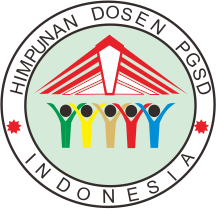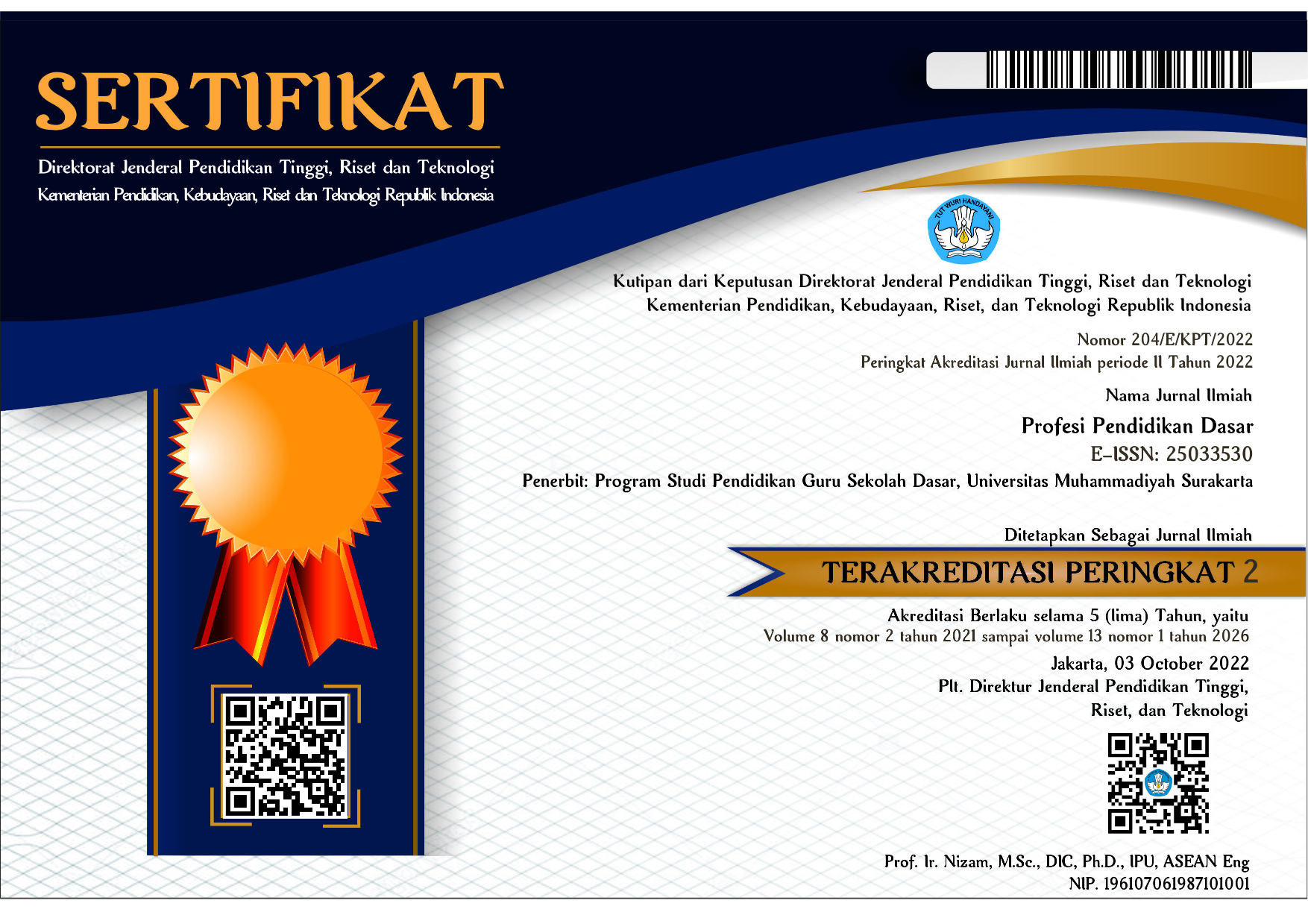The Relationship between Multiple Intelligences of Preservice Elementary Teacher toward Their Gender and Performances
Muhammad Ikhlas(1*), Kuswanto Kuswanto(2), Rosario F. Quicho(3)(1) Central Luzon State University, Phillipines
(2) Central Luzon State University, Phillipines
(3) Central Luzon State University, Phillipines
(*) Corresponding Author
Abstract
This research studies whether there is a significant relationship between the multiple intelligences of pre-service elementary teachers, their gender, and their performances. The survey method has been used for this study. A “Multiple Intelligence Profiling Questionnaire III (MIPQ-III)” was used to collect the multiple intelligences of the participants. Reliability-test has been used to see the consistency of the questionnaire. In order to analysis of the data, descriptive statistics, independent sample t-test, and Pearson correlation were used for this study. Results showed that naturalistic intelligence has the highest mean score. Meanwhile, logical-mathematics intelligence has the lowest mean score. Results also showed that logical-mathematic, verbal-linguistic, spatial, bodily-kinesthetics, and interpersonal intelligence have differences based on gender, while other intelligence has no differences. Furthermore, results also show that all intelligence, excluding naturalistic, positively correlates with the performances. Lastly, hierarchical regression shows that among the multiple intelligences, the logical-mathematics intelligence becomes a predictor for the performance of the pre-service elementary teachers. The implications of this study, such as the results, show a relationship between multiple intelligence and elementary school pre-service teachers. Besides that, it is found that the multiple intelligence of elementary pre-service teachers has a wide variety of impacts on the performance of those pre-service teachers in the future. Thus, it is expected that relevant stakeholders can better review these aspects, especially in the curriculum
Keywords
Full Text:
PDFReferences
Ahmadian, M., & Hosseini, S. (2012). A study of the relationship between Iranian EFL learners’ Multiple Intelligences and their performance on writing. Mediterranean Journal of Social Sciences, 3(1), 111-126. https://doi.org/10.5901/mjss.2012.03.01.111
Ary, D., Jacobs, L. C., Sorensen, C., & Razavieh, A. (2010). Introduction to Research in Education. Cengage Learning.
Armstrong, T. (2009). Multiple intelligences in the classroom. ASCD.
Biria, R., Boshrabadi, A. M., & Nikbakht, E. (2014). The relationship between multiple intelligences and Iranian EFL learners’ level of L2 lexical knowledge: The case of gender. Advances in Language and Literary Studies, 5(3), 9-17. http://dx.doi.org/10.7575/aiac.alls.v.5n.3p.9
College of Education of Central Luzon State University. (2016). Curricular Offerings. https://ced.clsu.edu.ph/curricular%20offerings.php
Domjan, M. (2014). The Principles of Learning and Behavior: Nelson Education.
Ekinci, B. (2014). The relationships among Sternberg's triarchic abilities, Gardner's multiple intelligences, and academic achievement. Social Behavior and Personality: an international journal, 42(4), 625-633. https://doi.org/10.2224/sbp.2014.42.4.625
Erdem, D., & Keklik, I. (2020). Multiple Intelligences Profiles in Prospective Teachers. Education Reform Journal, 5(1), 27-44. http://dx.doi.org/10.22596/erj2020.05.01.27.44
Ferry, B., & Kervin, L. (2011). Using Online Simulation to Engage Users in an Authentic Learning Environment. In Gaming and Simulations: Concepts, Methodologies, Tools and Applications (pp. 1460-1476): IGI Global. https://doi.org/ 10.4018/978-1-60960-195-9.ch514
Fraenkel, J. R., Wallen, N. E., & Hyun, H. H. (2011). How to design and evaluate research in education. McGraw-Hill
Furnham, A., & Buchanan, T. (2005). Personality, gender and self-perceived intelligence. Personality and individual differences, 39(3), 543-555. https://doi.org/10.1016/j.paid.2005.02.011
Gardner, H. (1993). Multiple Intelligences: The Theory in Practice. Basic Books.
Gardner, H. (2000). Intelligence reframed: Multiple intelligences for the 21st century. Hachette
Gardner, H. (2011). Frames of mind: The theory of multiple intelligences. Hachette
Gardner, H., & Hatch, T. (1989). Educational implications of the theory of multiple intelligences. Educational researcher, 18(8), 4-10. https://doi.org/ 10.3102/0013189X018008004
Işık, D., & Tarım, K. (2009). The effects of the cooperative learning method supported by multiple intelligence theory on Turkish elementary students’ mathematics achievement. Asia Pacific Education Review, 10(4), 465-474. https://doi.org/10.1007/s12564-009-9049-5
Javanmard, Y. (2012). On the relationship between multiple intelligences and their performance on vocabulary tests among Iranian EFL learners. Global Journal of Human Social Science, 12(12), 61-73. https://globaljournals.org/GJHSS_Volume12/9-On-the-Relationship-Between.pdf
Koura, A. A., & Al-Hebaishi, S. M. (2014). The Relationship between multiple intelligences, self-efficacy and academic achievement of Saudi gifted and regular intermediate students. Educational Research International, 3(1), 48-70. http://www.erint.savap.org.pk/PDF/Vol.3(1)/ERInt.2014(3.1-05).pdf
Lin, S. C. (2009). Gender and major differences in self-estimates of different aspects of Gardner’s multiple intelligences: A study of the undergraduate pre-service teachers in Taiwan. Asian Social Science, 5(5), 3-14. https://doi.org/ 10.5539/ASS.V5N5P3
Loori, A. A. (2005). Multiple intelligences: A comparative study between the preferences of males and females. Social Behavior and Personality: an international journal, 33(1), 77-88. https://doi.org/10.2224/sbp.2005.33.1.77
Mackey, A., & Gass, S. M. (2005). Second language research: Methodology and design. Lawrence Erlbaum Associates Publishers.
Madkour, M., & Mohamed, R. A. A. M. (2016). Identifying College Students' Multiple Intelligences to Enhance Motivation and Language Proficiency. English Language Teaching, 9(6), 92-107. https://files.eric.ed.gov/fulltext/EJ1101228.pdf
Meneviş, İ., & Özad, B. E. (2014). Do age and gender influence multiple intelligences? Social Behavior and Personality: an international journal, 42(1), 9S-19S. https://doi.org/10.2224/sbp.2014.42.0.S9
Nilsson, P., & Loughran, J. (2012). Exploring the development of pre-service science elementary teachers’ pedagogical content knowledge. Journal of Science Teacher Education, 23(7), 699-721. https://doi.org/10.1007/s10972-011-9239-y
Ocak, G., & Dermez, H. G. (2008). the Fulfilment Level of social skills of 4th and 5th Grade students at Primary school According to Multiple Intelligence types. The New Educational Review, 16, 157-176. https://tner.polsl.pl/e16/a12.pdf
Pour-Mohammadi, M., Abidin, Z., Jafre, M., & Yang Ahmad, K. A. B. (2012). The Relationship between Students' Strengths in Multiple Intelligences and Their Achievement in Learning English Language. Journal of Language Teaching & Research, 3(4). https://doi.org/10.1.1.657.9827
Pritchard, A. (2008). Ways of learning: Learning Theories and Learning Styles in the Classroom. Routledge.
Rad, R. S., Khojasteh, L., & Kafipour, R. (2014). The Relationship between Multiple Intelligences and Writing Skill of Medical Students in Iran. Acta Didactica Napocensia, 7(3), 1-9. https://files.eric.ed.gov/fulltext/EJ1053260.pdf
Razmjoo, S. A. (2008). On the relationship between multiple intelligences and language proficiency. The Reading Matrix, 8(2). https://citeseerx.ist.psu.edu/viewdoc/download?doi=10.1.1.540.3303&rep=rep1&type=pdf
Sadeghi, K., & Farzizadeh, B. (2012). The relationship between multiple intelligences and writing ability of Iranian EFL learners. English Language Teaching, 5(11), 136-142. https://files.eric.ed.gov/fulltext/EJ1080111.pdf
Saricaglu, A., & Arikan, A. (2009). A Sudy of Multiple Intelligences, Foreign language Success and Some Selected variables. Journal of Theory and Practice in Education, 5(2), 110-122. https://files.eric.ed.gov/fulltext/ED506218.pdf
Savas, P. (2012). Pre-service English as a foreign language teachers' perceptions of the relationship between multiple intelligences and foreign language learning. Learning and Individual Differences, 22(6), 850-855. https://doi.org/10.1016/j.lindif.2012.05.003
Shahzada, G., Ghazi, S. R., Khan, H. N., Iqbal, S., & Shabbir, M. N. (2011). Self-perceived multiple intelligences of male and female. Mediterranean Journal of Social Sciences, 2(1), 176. http://www.richtmann.org/journal/index.php/mjss/article/view/10765
So, W. W. M., Chen, Y., & Wan, Z. H. (2019). Multimedia e-learning and self-regulated science learning: A study of primary school learners’ experiences and perceptions. Journal of Science Education and Technology, 28(5), 508-522. https://doi.org/10.1007/s10956-019-09782-y
Tirri, K., & Nokelainen, P. (2008). Identification of multiple intelligences with the Multiple Intelligence Profiling Questionnaire III. Psychology Science, 50(2), 206. https://citeseerx.ist.psu.edu/viewdoc/download?doi=10.1.1.522.6173&rep=rep1&type=pdf
Zahedi, S., & Moghaddam, E. M. (2016). The relationship between multiple intelligences and performance of EFL students in different forms of reading comprehension tests. Theory and Practice in Language Studies, 6(10), 1929-1939. https://www.academypublication.com/ojs/index.php/tpls/article/view/tpls061019291939
Article Metrics
Abstract view(s): 1372 time(s)PDF: 729 time(s)
Refbacks
- There are currently no refbacks.


















